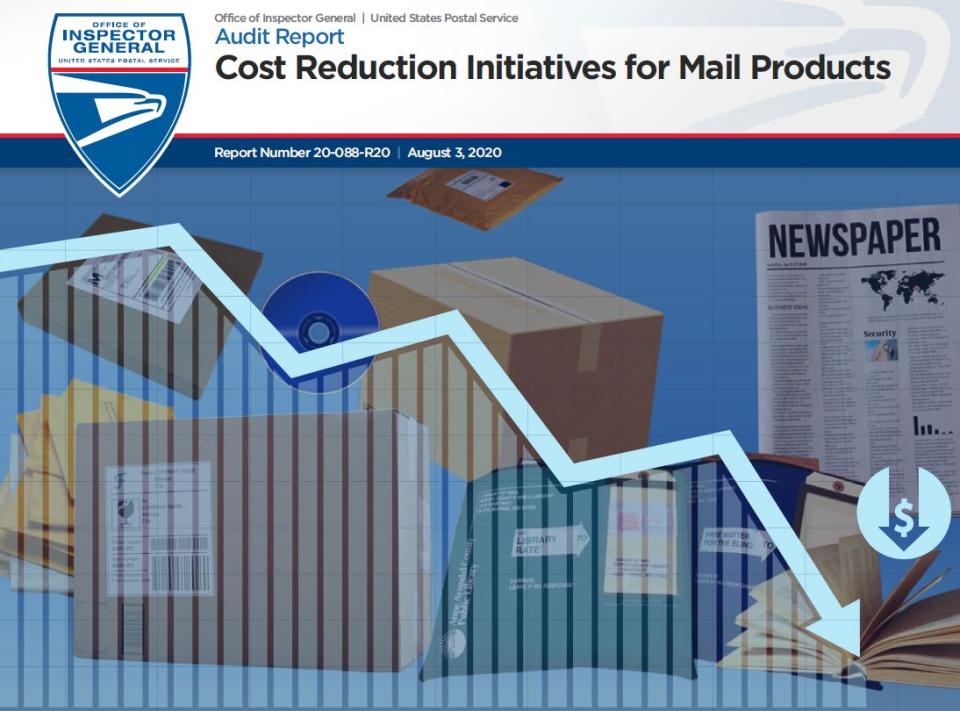Cost Reduction Initiatives for Mail Products
Objective
The Postal Accountability and Enhancement Act of 2006 requires that each class of mail or type of mail service covers their direct and indirect costs. Over the past 10 years, several U.S. Postal Service market dominant products continuously failed to cover their attributable costs. Currently there are six market dominant products that are not covering their direct and indirect costs (underwater products). In fiscal year (FY) 2019, total loss from these underwater products was about $1.6 billion.
Further, some market dominant mail products have had notable declines in cost coverage over the last 10 years. Unlike competitive products, market dominant product price increases are restricted to the Consumer Price Index, with a price cap applied to each mail class.
Our objective was to evaluate opportunities to reduce mail product costs. This audit was initiated to review cost reduction initiatives specific to underwater products; however, the issues we identified impacted more than just underwater products.
Our audit was in the fieldwork stage when the President of the United States issued the national emergency declaration concerning the novel coronavirus disease outbreak (COVID19) on March 13, 2020. The results of this audit do not reflect any process and/or operational changes that may have occurred as a result of the pandemic. We understand COVID-19 may have caused further decline in cost coverage for some mail products; however, it is too early to determine the full impact of this situation.
Findings
Opportunities exist for the Postal Service to reduce costs for mail products. Specifically, the Postal Service needs to address several mail preparation issues and enhance reporting and tracking of mail irregularities.
We identified several mail preparation issues related to bundle strapping, the use of sacks, shrink-wrap, and paper quality that increased mail product costs. These issues caused increased bundle breakage which resulted in manual mail processing and increased costs for mail products. We estimated that for FY 2018 – FY 2019, the Postal Service incurred about $48 million annually in additional costs to process broken bundles.
We found that personnel did not regularly record or communicate mail preparation and quality issues to mailers and within the Postal Service to ensure they were corrected, charged back to the mailer or addressed with updated mail preparation guidelines. Scans of mail irregularities were not always captured and complete. Further, scanners were not readily accessible to record commonly identified irregularities and report them for corrective action.
We observed clerks not reporting mail deemed non-machinable into the mail irregularity reporting system because the mail was technically prepared in accordance with current Postal Service guidance. Had the information been reported, management could have reviewed these irregularities and updated mail preparation requirements as necessary.
Finally, we saw loose bundle straps being replaced to avoid having to manually process broken bundles. However, Postal Service personnel did not report the re-strapped bundles as a mail irregularity because current policy does not require reporting of re-strapped bundles.
There are several Postal Service groups that develop, implement, and monitor holistic cost reduction strategies and communicate with mailers. However, there is no centralized group focused on developing product-specific cost reduction initiatives or communicating issues related to mail preparation irregularities. Cost coverage for some mail products will likely continue to decline if there is no dedicated group focused on addressing product-specific costs. Minimally, a centralized group specifically focused on reducing costs for underwater market dominant products is essential for improving cost coverage.
Recommendations
We recommended management:
- Create a dedicated group to establish metrics, analyze cost trends, and track mail irregularity reports to implement cost reduction initiatives; recommend updates to mail preparation guidelines; and communicate mail irregularities to mailers, as appropriate, particularly for those products significantly struggling to cover their costs.
- Update mail preparation guidelines to set appropriate mail preparation standards that align with automation to reduce costs associated with bundle breakage and manual processing of machinable mail.
- Develop processes to ensure mail irregularities are recorded in the facilities, scanners are placed at key locations where mail irregularities are identified, and mail irregularity reports are distributed to Postal Service personnel and mailers, as appropriate.

